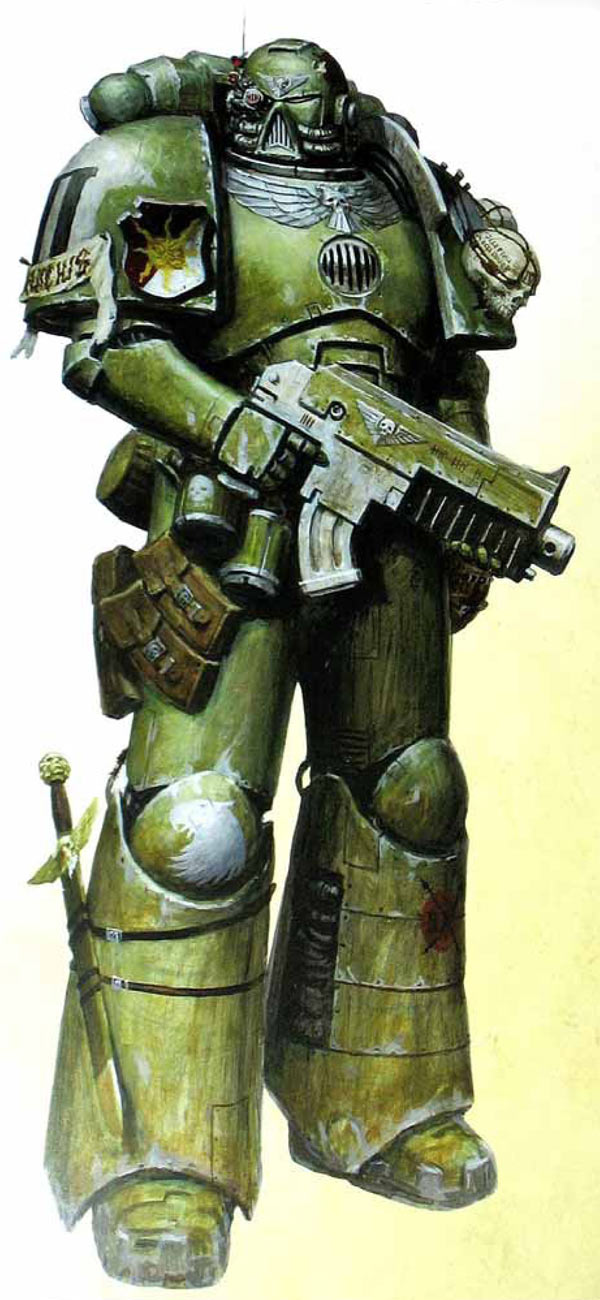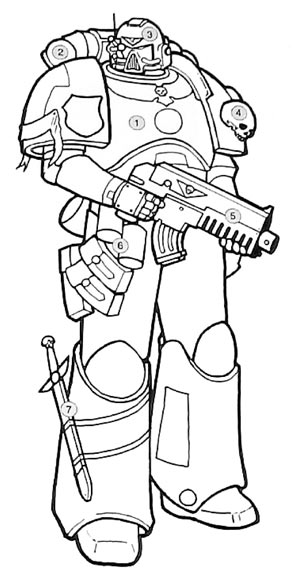
RAPTORS TACTICAL SQUAD
SPACE MARINE
All marks of Space Marine armour have many variants. Some do not contain all the original features, others, as in this case, utilise parts from different marks of armour. Armour is usually personalised by each Space Marine, and is revered as a holy relic of the Chapter. Suits or parts of suits can be very old and are often reused many times. Like all power armour, this suit contains an exoskeletal array of actuators and fibre bundles which replicate muscular commands via a neurone interface that literally plugs into the wearer's spinal column, (via his black carapace), to his motor-nervous system. Through this interface, the heavy armour becomes part of the wear and responds to his movements and mind-impulse controls without adding any encumbrance, despite the suit's weight when inert. Whilst appearing heavy and unwieldy, this Space Marine will experience little weight gain and retains almost his full array of movements and agility. The muscle fibre bundles and actuators actually increase the (already considerable) strength of the wearer, allowing him to lift heavier loads or jump greater distances than when not wearing the suit. The outer, armoured layer of this powered armour consists of shaped adamantium and plasteel plates, encased in a ceramite ablative layer. The armour is shaped to deflect as well as absorb the energy of incoming blows. The shoulder pads of this suit contain small, auto-responsive plates which burst outwards in a micro-explosion to counteract the energy of an incoming attack and prevent penetration. Beneath the armoured protection lies the internal workings of the suit's life-support and combat systems. The armour contains numerous life support systems. The lower back holds a liquid high-protein food store, which when combined with the Space Marine's genetically enhanced metabolism produces no waste and keeps a Space Marine's body functioning without the need for any other nourishment. During battle there is no need for this Space Marine to stop to eat or drink as the suit provides all his nutrition. The suit also has its own back-up power supply and a solar array to recharge this supply, meaning the suit can operate for a short time without its back pack. The suit also contains a de-tox injector with five doses. This will counteract the effects of most common poisons and toxins. The injector can be also be used for stimulants and (in contravention of Codex Astartes guidelines), some Chapters have used it to administer combat drugs. The palm of the gauntlets contain sensors to read information from weapons held in the hands, and to pass genetic identification codes to the weapons. Without the proper code, this Space Marine's boltgun will not function. The soles of the boots are magnetic, as well as being constructed of a micropore adherent compound, meaning a Space Marine will not slip on even the slickest surfaces. The magnetic function can be turned on or off as needed. The main power source for the suit is situated in the backpack. This highly efficient sub-atomic core provides the power for all the internal systems. The suit does contain a reserve supply and a back-up micro-solar panel array in case of emergencies. The reserve power source can be recharged via the solar panel, and when fully charged should be enough to last a month (with all non-vital systems disabled), without the need for major maintenance or resupplying. Thermal waste dissipators form the characteristic nozzles on the backpack. This thermal waste can be used as limited manoeuvring thrusters in zero-gravity. The backpack also contains this suit's oxygen supply and air purification system that allows the wearer to breath in toxic environments. Combined with a Space Marine's multi-lung implant, the wearer can operate unhindered in any atmosphere, as well as underwater and in hard vacuum. Air intakes are also situated on the backpack. The lower part of the backpack is the temperature regulating system. In combat, with the suit functioning at maximum capacity, heat can build up rapidly. Settings for heat control can be adjusted depending upon what environment the suit is operating in, obviously retaining more heat in cold conditions or in the -278 centigrade of deep space than in hot conditions. On Taros, this suit will be optimised for the planet's mean average temperature. Within the armour, the wearer will experience only minor temperatures fluctuations as the suit maintains the correct temperature to keep the Space Marine operating at peak physical effiency. This Space Marine's upgraded Mark VII helmet contains most of the suits combat systems. All of these helmet systems are relerred to by one title - auto-senses. Features include the primary, thought-activated, comms-link. This Space Marine's helmet also has an additional comms-booster and scrambler attachment, to block enemy attempts to listen in to communications channels. The right eye also Includes range-finder, targeter and target recognition friend or foe upgrades to the helmet's basic set. Such equipment is more common in Devastator squads, but not limited to them. The visor displays tactical information. This includes maps, waypoint markers, compass, as well as calling up weapon-data, passed through the weapon's grip and the palm of the glove. Primarily this would be an ammunition counter display, but also gives emergency warnings about overheating and jams. This helmet also incorporates visual magnification up to x4, which when combines with the wearer's Occulobe implant means a Space Marine sees very well in most conditions. The visor also includes basic infra-red scanning. Through his auto-senses, the Space Marine can access full diagnosis of the armour's operating status and relay information about the external environment, such as atmospheric composition, barometric pressure, the presence of harmful chemicals and toxins etc. Diagnostic sensors are positioned in various places on the suit to scan for such information. The helmet can also display biological information about the Space Marine himself, heart rate (for both hearts - Space Marines have two), blood pressure, toxin levels, the workings of the Larraman's organ or Oolitic kidney, to assess internal damage. These bio-status read-outs can also be broadcast to Space Marine command units for monitoring during battle and training. As well as containing the communications equipment, the helmet's ear pieces screens the wearer from sonic attacks and includes amplifiers to the Space Marine's Lyman's ear, giving sharper hearing and allowing the Space Marine to filter out or enhance specific sounds. The Lyman's ear also means a Space Marine is unlikely to become dizzy or disorientated, even when hit by strong blast waves. The grill on the helmet contains a microphone, allowing the wearer to talk normally through the helmet or amplify his voice over a short distance, sometimes useful in the din of battle. If the atmosphere allows, the grill can open to allow the wearer to breath the atmosphere rather than use the air purification equipment or internal air supply. Finally, the helmet visor incorporates an auto-reactive photo-chromatic visor, that protects the wearer from light level changes, dimming or blacking out completely should the wearer be exposed to sudden, dazzling light. Strapped to the left shoulder pad are two engraved skulls. These are holy relics, which maybe former owners of the armour, fellow squad members killed in battle or those of worthy foes carried as trophies. Many such sub-cults exist throughout the Space Marine Chapters, with each following its own rituals and traditions, often inherited from the Chapter's recruitment world. These relics will be gifts from the Company Chaplain, rewards for exceptional dedication or bravery in battle. The plastron chest eagle is worn as the symbol of this Space Marine's loyalty to his Emperor. Chest eagles are common to all Space Marine Chapters. The Raptors Chapter badge is a white eagle's head. It is worn on the left shoulder pad (the beak is just visible) and repeated on the right knee-pad. The right shoulder pads bears the Tactical squad markings (large arrow) and the squad number in roman numerals, in this case second Tactical squad. Underneath this is a name scroll. This personal cloth scroll bears the Space Marine's name, and, like all the non-codex additions to this armour will have been donated by the Company Chaplain to reinforce the Space Marine's faith and morale. The badge of the Taros Campaign (crossed spears on a red disk), have been temporarily stencilled onto the left lea greave and helmet. This symbol should be carried by all the Emperor's forces fighting on Taros, regardless of which fighting arm or organsiation they are from. The badge helps identify the forces as loyal during combined operations, it will be removed at the conclusion of the campaign. As a veteran, this Space Marine bears his own personal heraldry; a shield pinned to the right shoulder pad, bearing a sun symbol. The meaning of this is unknown, but it may hark back to a time before this Space Marine was recruited. Finally, this Space Marine's boltgun bears twelve kill markings scored onto the weapon's case, probably from previous missions. As a member of a Tactical squad, this Space Marine's principle weapon is the boltgun. This weapon is a standard model Mark IV with a sickle magazine containing twenty bolts. Each bolt is a rocket propelled, armour-piercing, mass-reactive, explosive round. Bolts explode after penetrating a target, and are capable of destroying small vehicles, as well as having horrific effects on infantry. The weapon has single shot and semi-automatic setting, firing a burst of three bolts in quick succession. The boltgun also includes a palm print sensor for genetic identification coding. In addition to his boltgun, Brother Kalius carries other combat equipment. Hanging from his utility belt are two fragmentaion grenades. He also carries three spare magazine pouches for his boltgun. The cylinderical object hanging from his back, below the backpack, is harder to identify. Given the nature of the Raptors' first mission on Taros, this may well be a shaped demolition charge, carried to destroy the target missile silos. Not visible here, the Space Marines will also be carrying krak grenades, and may well also carry a bolt pistol as a secondary weapon. The Space Marine's last weapon, and his only close combat weapon, is his combat knife. This highly ornate piece, bearing a dedicational eagle crossguard, heavy pommel and a 50cm, blade is almost a short sword. Used for hand-to-hand combat, it is kept honed to a keen edge. It is also used during the Chapter's ceremonies and rituals, and will have been blessed before battle. It is not a bayonet, and cannot be fitted to the boltgun, it must be wielded by hand. Hand-to-hand combat and knife-fighting is part of all Space Marine's basic training, instilling skills which will continue to be honed throughout Brother Kalius' service to the Emperor.  Brother Kalius of the Raptors Chapter, 3rd company. He is a veteran brother of 2nd Tactical squad, seen here deployed for the attack on missile silo Decima.
|
 This Space Marine wears a suit of Mark VII power armour, sometimes referred to as 'Armorum Impetor' or 'Eagle Armour', although on this particular set of armour the Chapter Artificers have replaced the breastplate with one converted from an older Mark V suit, with the re-instigation of the chest eagle and the power cables relocated to the interior.
This Space Marine wears a suit of Mark VII power armour, sometimes referred to as 'Armorum Impetor' or 'Eagle Armour', although on this particular set of armour the Chapter Artificers have replaced the breastplate with one converted from an older Mark V suit, with the re-instigation of the chest eagle and the power cables relocated to the interior.